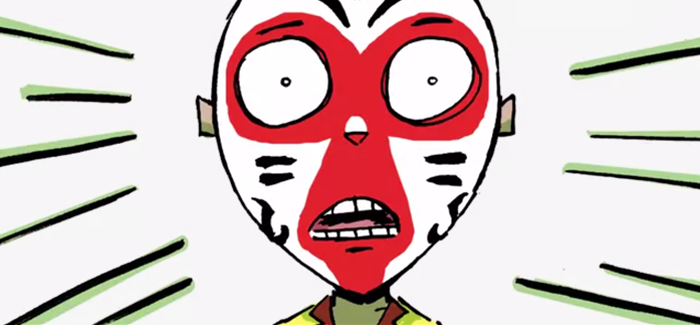
Panels from Monkey Fist. (Courtesy of the Sun Bros.)
Wesley and Brad Sun on comics, Kickstarter, and their latest collaboration, Monkey Fist.
Wednesday lunch at the Divinity School, held in the wood-paneled portrait-lined Swift Common Room, is one of the best-kept secrets at the University.
For five dollars, you get a vegetarian lunch, a smidgeon of wine if you want it, and a lecture by someone who’s doing something interesting. At Div School lunches, I’ve learned about a Hyde Park synagogue that ripped out its lawn to grow food for the hungry and how writer Anne Ford, AM’99, finds the subjects for her Chicagoans interview series.
[[{"type":"media","view_mode":"media_original","fid":"1144","attributes":{"alt":"","class":"media-image","height":"259","typeof":"foaf:Image","width":"460"}}]]
Last week, lunch was a goat cheese tart and Brussels sprout slaw (sounds unpromising, but I could have eaten a mixing bowl of that stuff) while the lecture topic was comics as art objects.
Wesley Sun, MDiv’08, director of community engagement at the Div School, has been collaborating with his brother Brad on comics since 2011. Wesley is the primary writer, Brad the cowriter and artist.
[[{"type":"media","view_mode":"media_original","fid":"1146","attributes":{"alt":"","class":"media-image","height":"259","typeof":"foaf:Image","width":"460"}}]]
They’ve self-published two books so far: Chinatown (2012) and Apocalypse Man (2013). A Kickstarter campaign for their latest, Monkey Fist, an adaptation of the Monkey King story from Chinese literature—albeit set in the fast-food restaurant Fishy Burger—has nearly reached its $14,000 goal. They’ve raised $11,500 from more than 200 backers.
So here are five interesting things the Sun Bros. had to say:
1. While painting is clearly an art object, and a reproduction is an inferior copy, comics present a more complicated picture. Brad has shown his comic-book art in a gallery setting, but “in my opinion, it’s the printed book that is the true art,” he says. “The pages are just the component pieces. The true art is the mass-produced object.”
2. The dimensions of a standard comic book were determined by the size of a broadsheet newspaper, folded in quarters. “It was not an art decision,” says Brad, “it was a practical decision.”
3. While Chinatown was printed in color on high-quality paper, Apocalypse Man was printed in black and white on inexpensive paper—not to save money, but for aesthetic reasons. The Sun Bros. wanted it to have the same feel as the 1980s newsprint Ninja Turtle comics they loved as children. The printer pointed out that newsprint tends to smear, so they settled on “the cheapest paper that doesn’t smudge,” says Wesley.
4. Unlike novelists—who often have no say in the production of their books, even what the cover will look like—self-publishing comics artists are heavily involved in design and printing. Decisions about page dimensions, paper stock, and ink color are all a part of what they’re trying to do: “We use the different elements as storytelling devices,” says Wesley.
5. According to their write-up on the Kickstarter site, backers who pledge $300 or more to Monkey Fist are entitled to “a customized drawing of you by Brad beating up anyone you want. You tell us who, provide reference photos, and Brad will do the rest.” So far, four people have signed up for this option.
[[{"type":"media","view_mode":"media_original","fid":"1147","attributes":{"alt":"","class":"media-image","height":"259","typeof":"foaf:Image","width":"460"}}]]
